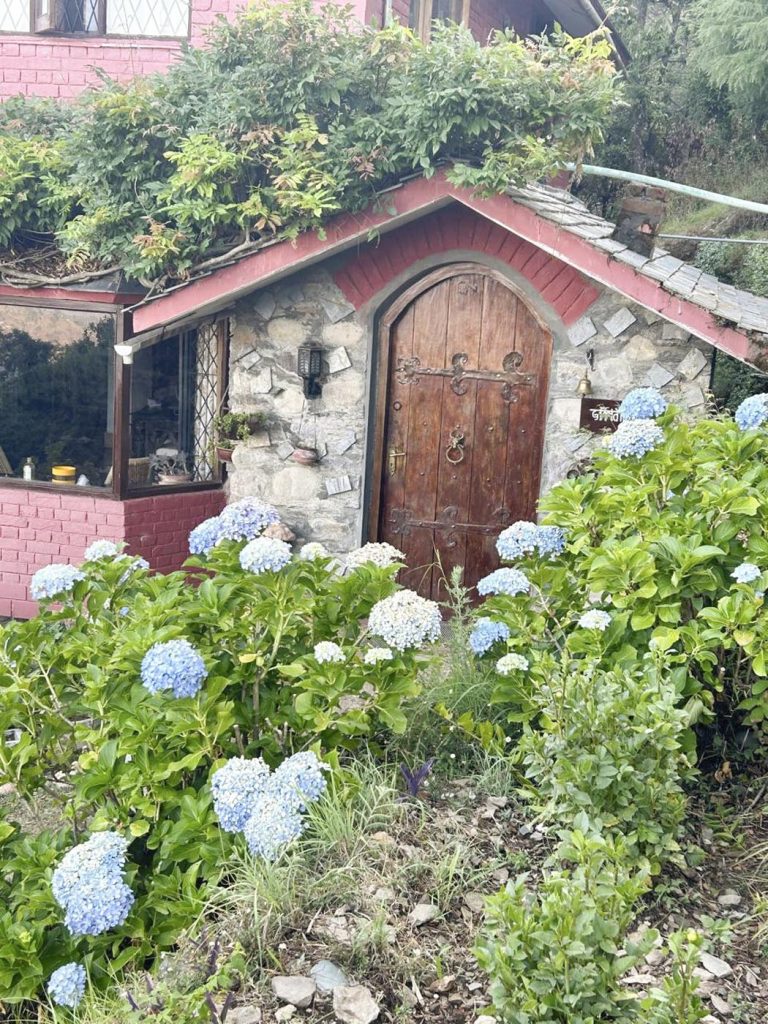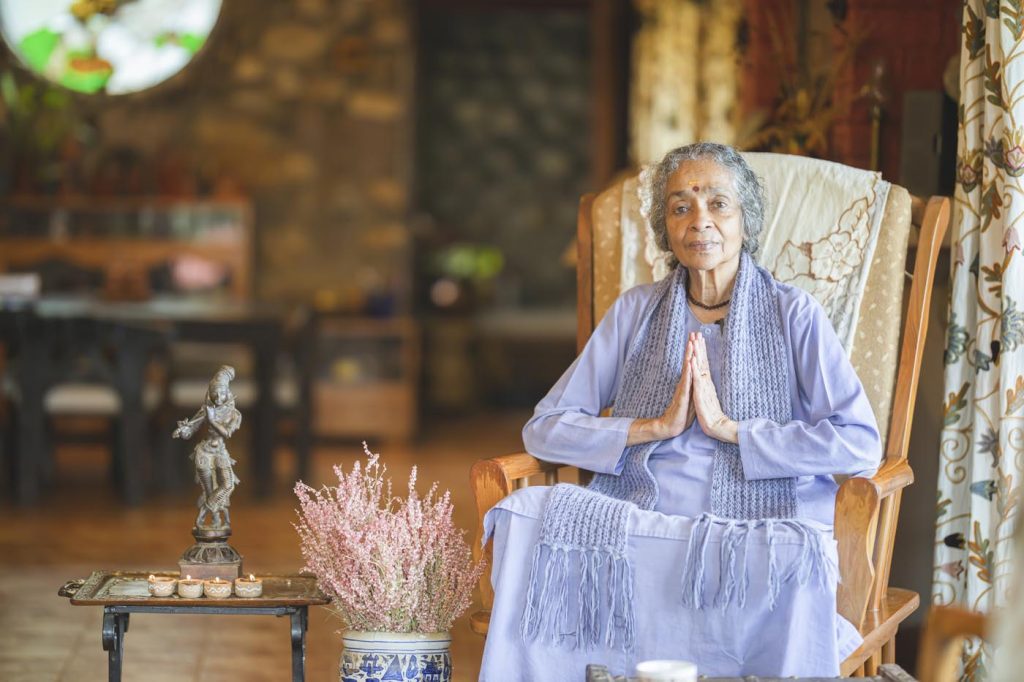By Erica Bassani, Rishikesh
It was my great good fortune to interview this 84-year-old saint at her Rishikesh ashram March 15, 2023. After a brief chant we began.
What is the universal power of the Shakti?
She is Shakti, power. She is that spark that starts the engine. The engine is Siva. There is a beautiful conversation between Parvati and Siva. She (Parvati) was doing tapas (austere practices) to win Siva’s love, and He told her, “I am complete in myself, I do not need anybody.” To this, She replied, “No, you need me. Without my power, you cannot achieve anything in this world.” Without Shakti, all of creation would not even have started. All of Nature that we see is Her form. This is also depicted in the incredible icon of Kali dancing on Siva’s seemingly dead body: Siva, without Shakti, is only shava—a corpse! This is an example to show that the male is powerless without the female Shakti! Such was the importance given to women throughout our history and mythology.
Siva and Shakti are always united?
In the Skanda Purana, we find that the masculine and feminine are eternal principles involved in the projection of the universe. They are never separate and are fundamentally one—like gold and the ornaments made from it. Siva is inert. Shakti is maya, an illusion—which offers pleasure, colors, music and beauty. All arts and sciences come from Her, in the form of Saraswati. Saraswati is not a male God, she is a Goddess. Saraswati is also the Goddess of learning, to whom the children pray so they can learn better. Siva is the formless, actionless witness, the stage on which Shakti plays.
Can you tell me about the forms of the sacred feminine in the Hindu tradition, and how they inspire you?
In Hinduism, all women are sacred. In ancient times, the name Devi (Goddess) was added to each woman’s name: if her name is Kalyani, it becomes Kalyani Devi. Every woman is considered part of the Divine Mother. The many taboos related to women are not meant to diminish them, but rather to protect them. The woman is the womb of the world; without her, there are no people. So, she must be protected. For example, during her menstrual period, the woman would rest quietly in her room, and food would be brought to her so that she could regenerate her health. There was a hyper-protective attitude towards women. Also, women ruled in the house: they worked in the fields around the house and cared for the animals and the children. Today many women go to work [outside the home] almost immediately after having delivered a baby. She has some weeks or a month off, and then again she is pushed into this stream of work, and the child ends up in the hands of someone else who takes care of it. It used to be important for children to be brought up in their mother’s love and care. The best formula is made by nature herself. It was fundamental for the culture. The restrictions in which the woman lived were to protect her well-being and that of the coming generation that came through her. But with the arrival of Western ideas, Indian women began to feel limited by these customs.
How do we recognize ourselves as divine? How do we surrender to life?
Surrender can only happen through bhakti, devotion. You can surrender to God only if you have the deepest love for Him, a very deep connection. It is impossible to surrender to the Divine if we are egoistic. Ego makes us do everything we can to sustain and even strengthen our individual attitudes. The ability to give yourself to the Divine only comes when you have a great, great love for God—a non-human love. We can only rely on something far, far, far superior to us, which at the same time is so intimate, so wonderful and so beautiful. Otherwise, you are just playing with words. It means nothing.
More and more women are experiencing anger (often unconscious) towards the male. How can we transform these emotions into love, understanding and compassion, while also transforming ourselves from victimhood to freedom?
This is only possible through knowledge. Everything is caused by ignorance. Men must understand the crucial role that the woman plays in life as a creatrix. Without her, there would be no creation. Your Western men must be re-educated to recognize you as Divinity.
On the spiritual path, how important is mutual support
between women?
It is very important. You may have married the best man in the world and have all the beautiful children you want, but it will always be important to cultivate female friendships. This is why we have many festivals here in India where women meet together. Female friends can have fun, support each other and get through difficult times. Because only a woman can know a woman’s heart. Men cannot actually know what a woman is really about!
As women, we often feel a range of complexes around our appearance, rarely happy with how we look. How can the spiritual quest change the perception of one’s own bodily image?
Nowadays, there is so much stress around physical appearance. So many beauty products, clothes, this and that,… but true beauty will not emerge from that. Inner beauty, which depends on kindness, compassion—qualities that women have—the desire to help others, maternal instincts…. These are the things you have to cultivate. These constitute the true beauty of a woman. Some women, even of a certain old age, have a very attractive aura of love around them, due to their inner beauty. Of course, it’s OK for young girls to make themselves pretty and all, it’s not a problem. Don’t go around with messy hair and wrinkled clothes—after all, remember you are a Goddess! But not all Deities are beautiful externally. Think of Kali, Durga, Chandi…. We have so many Goddesses who are not beautiful in appearance but are very forceful. So, women should cultivate their inner, uniquely feminine qualities. Then beauty will come out. If you want a plant to flourish, wet the roots, not the branches.
How do we fully and practically integrate with the Divine?
The supreme Divine is beyond duality and gender. We live in this dimension of time, space and causality, because that is how the mind works. But the Divine is in everything, in every creature, every star, every flower. So how can you talk about reconciliation? Aham asmi—“I am the Divine! I am Brahman.” Not only can women and men say this, but also any dog or cat. Only the human, however, can understand and experience this. You are. You are everything. I am. The Divine is not differentiated. Everything is That, and That is all. All life is One. There is no two. Everything is an emanation of that One. We are already complete, but in our ignorance we perceive differentiation and feel ourselves apart from the whole, separate from the rest. This is the one original sin in Hinduism. When that knowledge finally arises, we realize the unity of life. It cannot be cut into pieces. It is One. In differentiation it can manifest itself, just as electricity can manifest itself in various forms: in the fan, in the light, in the refrigerator, in the oven,…but the power is one. It is not two.

Why during their period should women not go to temples?
Temples are places with a very active pranic current which can lift our mind and energies to the higher chakras. Going to the temple when the prasoothi pranic current is active within us would create conflicting forces which, according to our sages, can cause infertility, endometriosis, tubal blockage, etc. So our taboos against entering temples were simply intended as a protection for women’s health. Men ignorant of our ancient culture took this opportunity to suppress and control women, but the original reason was well-intentioned. In fact, we have always worshiped God in female form. We have an infinite number of Goddesses in our pantheon. Even when a Goddess is related to her male counterpart, her name always comes first: Lakshmi/Narayana, Gauri/Shankar, Radha/Krishna. Her name comes first, because she is the Shakti, she is the power.
To which female Deity we can look for energy and courage?
Durga, Durga! She is the eternal feminine. She has no consort. She does not depend on anyone for Her power. She is said to have been created by male Deities, using the best of their powers, to kill the demon Mahishasura. She was generated by fire and is the very emblem of being a woman. All female Deities are powerful, and each has different characteristics. For good auspices we pray to Lakshmi. For art, science and wisdom, we pray to Saraswati. In ancient times, men prayed to Durga before going into battle, because She is the One who wins the war. In the Vedas, the Goddess of the Earth is praised as Prithvi—our first mother. From the Earth, we are born, and to the Earth we will return. Our tradition is to touch the Earth as soon as we get out of bed in the morning and ask Her forgiveness for stepping on Her during the day. We are taught from an early age to revere Her great stability and inexhaustible fertility. Similarly we revere our rivers and mountains. Our rivers are known as Goddesses, for the ancients knew them to be the arteries of the country—our very lifeblood—pumping their inexhaustible fund of life-giving waters from the mountains to the sea.
Mataji recites a beautiful prayer that ends with a very sweet Om Shanti Shanti Hari Om. She adds, “Again, Shanti, or Peace, is the name of a woman. And on that note, let us close.”
About the Author
The Author: Erica Bassani is a copywriter, author and spiritual seeker since her early twenties. She’s combined her highest passion with her deepest love by founding the Women Awakening Project (www.womenawakeningproject.com), a space to gather interviews with female masters of all spiritual traditions.

Thank you for sharing this beautiful interview. What a great perspective on the traditions, scriptures and role of women today. Mataji makes everything to simple and beautiful – filled with wisdom and sweetness. Yet it remains sublime and uplifting. Feel so grateful to read this and learn. Thank you!
Beautiful interview. Thanks for this divine exchange. Vanamali Maa is a powerhouse of love, bhakti and compassion.